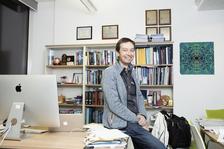Henry Chapman is a Lead Scientist at the Center for Free-Electron Laser Science CFEL at DESY and professor of physics at the University of Hamburg. (Credit: DESY, Gesine Born)
DESY Lead Scientist Henry Chapman will receive the Gregori Aminoff Prize for Crystallography 2021 from the Royal Swedish Academy of Sciences in Stockholm. Together with Jonas Hajdu from the University of Uppsala and John Spence from Arizona State University, Chapman will be honoured for “fundamental contributions to the development of X-ray free electron laser based structural biology”, as the academy announced.
Most processes in cells and organisms are controlled by proteins, making them the target of nearly all therapeutic drugs. The crystals that can be formed by proteins can diffract X-rays, allowing detailed, atomic-level information about their molecular structure to be determined using crystallography. This is vital for understanding how these biomolecules function and can help with the development of novel and improved drugs. However, protein crystals are often very small and sensitive, so are destroyed before enough diffracted X-rays can be measured.
Spence, Hajdu and Chapman have invented methods to gain unrivalled insights into biomolecules and other biological structures. The researchers use crystallographic principles, and have developed novel methods for use at a whole new generation of X-ray light sources: X-ray free-electron lasers (XFEL) are driven by powerful particle accelerators that bring electrons to high energies. The fast particles are then sent through a magnetic slalom course in which they emit laser-like X-ray pulses. XFELs like the European XFEL that runs from the DESY campus in Hamburg to the neighbouring town of Schenefeld are the brightest X-ray light sources in the world.
“X-ray FELs really did explode onto the scene just over a decade ago, with beams so strong that it seemed impossible to use them for measurements with the atomic precision needed for structural biology,” said Chapman, who is also a professor of physics at the University of Hamburg. “I was fortunate that there was a vision here in Hamburg to build up a scientific community and prepare for such beams, and that I was invited to be part of that community. I was equally fortunate to have wonderful scientific collaborations with Janos Hajdu and John Spence, as well as many other colleagues.”
The methods developed by Spence, Hajdu and Chapman have established protein crystallography at X-ray lasers and allowed for advances in many areas of structural biology. Examples include a better understanding of enzymes that can be measured at physiological temperatures with XFELs, unravelling the process of photosynthesis, new insights into gene regulation, and the ability to obtain the molecular structures of hormone receptors.
The central method for these investigations is serial femtosecond-crystallography SFX that has become one of the leading applications of X-ray FELs, since it allows structure determination from samples too small for conventional analysis, avoids radiation damage and allows time-resolved measurements, among other advantages. For SFX, many very small crystals are shot through the laser beam and analysed with femtosecond (quadrillionths of a second) X-ray pulses. All three awardees are spokespersons within the SFX user consortium at the European XFEL, which Chapman initiated in 2012..
The award, named after the Swedish mineralogist and artist Gregori Aminoff, is endowed with 80,000 Swedish crowns (around 7700 euros). It has been awarded for outstanding achievements in crystallography since 1979. The award ceremony will take place on March 26, 2021 in Stockholm at the annual celebration of the Royal Swedish Academy of Sciences.
(from DESY News)
Announcement by the Royal Swedish Academy of Sciences







